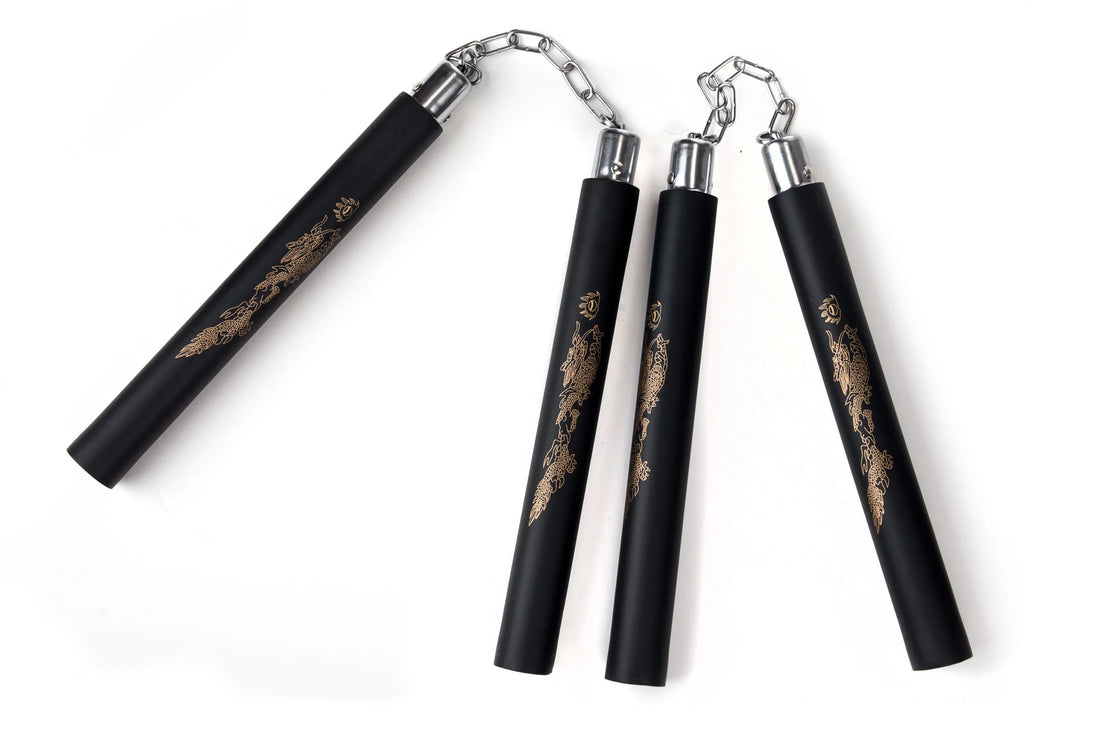In the vast realm of martial arts weaponry, few tools boast the iconic status of nunchucks. Also known as nunchaku, these dual sticks connected by a chain or rope have captivated practitioners and enthusiasts alike for centuries. In this comprehensive exploration, we will journey through the fascinating history of nunchucks, from their humble origins to their modern-day prominence in martial arts and popular culture.
Section 1: Origins and Early Development
The roots of nunchucks trace back to ancient Okinawa, Japan, where they began as an unassuming farming tool. Originally known as "Muge," these wooden flails served as a means for threshing grains. It wasn't until the 17th century that the Muge evolved into a formidable weapon in the hands of Okinawan martial artists.
The transformation from farm implement to weapon was a testament to the adaptability and ingenuity of the Okinawan people. As the region faced strict weapon bans imposed by Japanese rulers, the resourceful inhabitants repurposed the Muge into a compact and deadly tool for self-defense.
Section 2: Nunchucks in the Ryukyu Kingdom
Okinawa's unique martial arts culture, influenced by Chinese and indigenous fighting styles, saw the integration of nunchucks into traditional practices. Known then as "Nunchaku," these weapons became a symbol of resilience and a clandestine means of preserving martial arts knowledge during times of oppression.
Masters like Chikin Akamine and Motobu Choki played pivotal roles in refining nunchaku techniques, incorporating them into Okinawan martial arts systems. The weapon's popularity spread within the Ryukyu Kingdom and beyond, laying the groundwork for its continued evolution.
Section 3: Spread to Mainland Japan and Beyond
The 20th century marked a significant turning point for nunchucks as martial arts practitioners from Okinawa introduced them to mainland Japan. Initially met with skepticism, nunchaku gained recognition and acceptance, finding a place in various martial arts disciplines.
The global dissemination of nunchucks was further fueled by pop culture. Bruce Lee's iconic performances in movies like "Enter the Dragon" catapulted nunchaku into the international spotlight, solidifying its status as an integral part of martial arts weaponry.
Section 4: Nunchucks in Popular Culture
Nunchucks' journey from practical self-defense tool to pop culture phenomenon is a testament to their visual appeal and dynamic nature. From martial arts films to television shows and video games, nunchucks have become an enduring symbol of martial prowess.
Characters like Michelangelo from the Teenage Mutant Ninja Turtles and Michel Qissi's portrayal of Tong Po in "Kickboxer" further fueled the mystique surrounding nunchucks, captivating audiences and inspiring a new generation of martial artists.
Section 5: Nunchucks in Modern Martial Arts
As martial arts evolved and diversified, nunchucks found their place in various disciplines, including Karate, Kung Fu, and Kobudo. Contemporary martial artists have expanded the traditional techniques, incorporating acrobatics, spins, and intricate forms, pushing the boundaries of what can be achieved with this iconic weapon.
Section 6: Nunchucks Today - A Symbol of Skill and Discipline
In the present day, nunchucks continue to be revered as both a practical weapon and a symbol of skill and discipline. Martial arts schools worldwide include nunchaku training in their curriculum, recognizing its value in enhancing coordination, reflexes, and overall martial prowess.
Section 7: Navigating the Modern Market - Types of Nunchucks
The contemporary martial artist is spoilt for choice when it comes to nunchucks. Traditional wooden nunchaku, foam-covered practice versions, and even high-tech, retractable models cater to practitioners of all skill levels. Choosing the right type depends on individual preferences, training goals, and safety considerations.
Section 8: Nunchucks' Enduring Appeal and Future Prospects
The enduring appeal of nunchucks lies not only in their historical significance but also in their ability to adapt to the changing landscape of martial arts. As technology advances, we may see innovative materials and designs, but the essence of nunchucks as a symbol of discipline and skill is likely to persist.
Conclusion:
The history of nunchucks is a rich tapestry woven with threads of innovation, adaptation, and cultural significance. From a humble farming tool in Okinawa to a global icon in martial arts and entertainment, nunchucks have traversed a remarkable journey. As we continue to appreciate and practice the art of nunchaku, we honor the legacy of those who transformed a simple tool into a symbol of skill, discipline, and the enduring spirit of martial arts.
